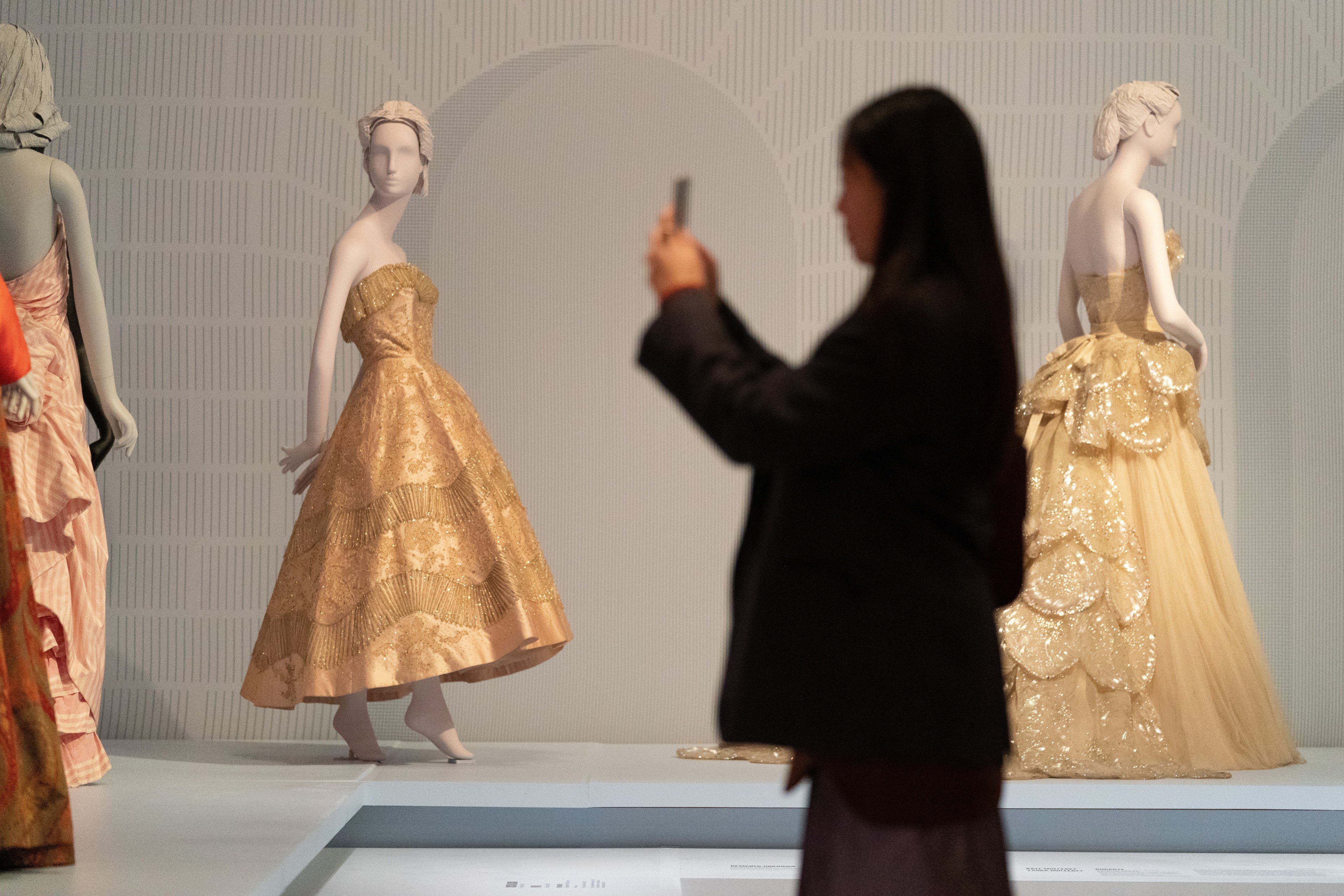The buzziest aspect of the de Young Museum’s new fashion spectacle isn’t the fashion at all. It’s the magic mirrors.
Three 3-foot-tall screens engineered by the museum’s corporate partners at Snap give visitors to Fashioning San Francisco: A Century of Style the chance to “try on” classic dresses through the uncanny lens of augmented reality.
“This is a chance for you to have fun,” said Rajni Jacques, global head of fashion and beauty at Snap during Wednesday’s press preview of the exhibition, “for you to be whimsical.”
The mirrors drew a sizeable crowd to a standing-room-only preview of the de Young Museum’s new haute couture-focused exhibition. The invited journalists, fashionistas and influencers jockeyed (politely) to try out the AR filters, which plop ordinary mortals into iconic dresses that seem designed for the gods.
The technology has previously appeared in museums and art fairs ranging from the Louvre to Art Basel to LA County Museum of Art, though the de Young installation is the first time the mirrors will remain for the entirety of an exhibition.
The de Young pulled out all the stops to make the tech come to life: Self-described “Snapchat Girls,” an effervescent trio representing the instant messaging app, were on hand to explain the setup, which the public can experience themselves beginning Friday through Aug. 11.
The full-length screens adjust to dress any body size or type—and after you snap, you can save the image of your well-dressed self to your phone—allowing visitors to (virtually) don formal fits by everyone from Yves Saint Laurent to Valentino to San Francisco designer Kaisik Wong.
“You step in front of the mirror like you’re in your own dressing room,” said Patricia Buffa, the museum’s director of digital strategy. Buffa said that while the digital and physical are typically in competition with each other, the approach here is to blend the two in a seamless fashion. “We want to put the visitor at the center instead of the objects.”
Yet to focus only on the AR component of the exhibition would be shortsighted. Despite what could appear to be Gen Z pandering represented by the mirrors, the exhibition’s greater appeal comes from the treasure trove of high fashion assembled from the museum’s permanent collection, one of the country’s most significant arrays of haute couture, built almost entirely from donations by Bay Area residents.
The exhibition’s wardrobe spans a century and includes 93 ensembles, many of which have never been on display before, in part because of their fragility. Under the direction of Laura Camerlengo, curator of costume and textile arts, the museum has divided the exhibition into seven sections that spotlight quintessential shapes like the little black dress, the ballgown and the suit.
A standout area is “Global Influences,” in which cultural borrowing—or more bluntly, appropriation—is placed into context. While ogling an African-style beaded dress, for example, museumgoers learn of Yves Saint Laurent’s connection to colonial France (the designer was born in Algeria).
“One of the most satisfying aspects of this exhibition was the opportunity for myself and our teams to really dig into the construction of each garment and see what the clothes could tell us,” Camerlengo said.
Another highlight is the decadent Christian Dior ballgowns, two of which were never owned and immediately designated as museum pieces. The San Francisco Examiner called the swoon-worthy Junon and Venus “priceless” in 1949. “They’re the absolute pinnacle of creativity and craftsmanship,” Camerlengo said.
The exhibition is a celebration not only of fashion artistry, but also San Franciscans’ role in harnessing it: the women who wore it, the philanthropists who supported it, the city that nourished it. As if to drive the point home, the physical space of the exhibition is built around iconic locales in the city: Early fashion is displayed in a facsimile of the Palace of Fine Arts, the little black dress is found in Grace Cathedral, the ballgowns festoon the Opera House. The exhibition is, in essence, a love letter to the city and its residents.
“The labels are a who’s who of the women who built San Francisco,” said Thomas Campbell, the director and CEO of the de Young.
It might not be customary to think of the City by the Bay as a high-fashion destination, but we have our own brand of innovation and style and an inclusive, experimental mindset. That comes to the fore in the avant-garde section, which highlights designers with strong local ties like Jean Paul Gaultier, John Galliano, Alexander McQueen, Vivienne Tam and Kaisik Wong. Pacific Rim influences are apparent in Oscar de la Renta designs, while French designer Christian Lacroix borrows across history.
Fashioning San Francisco isn’t just about looking and being looked at—it’s also an auditory journey. A vintage soundtrack crafted by local composer Mason Bates evokes a world of whimsy with songs like “Moonlight Cocktail” transportive to a bygone era.
The mirrors, too, make noise. When you step in front of the AR experience, a custom sound comes out, one that was crafted in conjunction with the exhibition’s curators. The Yves Saint Laurent piece has ding-like tinkling chimes, while the Kaisik Wong ensemble elicits more of a whoosh.
While the ravishing dresses of Gabrielle “Coco” Chanel, Christian Dior and Yves Saint Laurent may be out of reach for all but the wealthiest San Franciscans, the augmented reality mirrors offer the opportunity to democratize high fashion—a person with any size pockets both literally and figuratively can try on the gowns.
“It’s not just about looking at the art that’s in front of you,” Jacques said. “But engaging with that art, being part of the story.”
It’s just that the more compelling story isn’t to be found in your own reflection.
Fashioning San Francisco: A Century of Style
📍 de Young Museum, 50 Hagiwara Tea Garden Drive
🗓️ Jan. 20-Aug. 11
🔗 famsf.org
